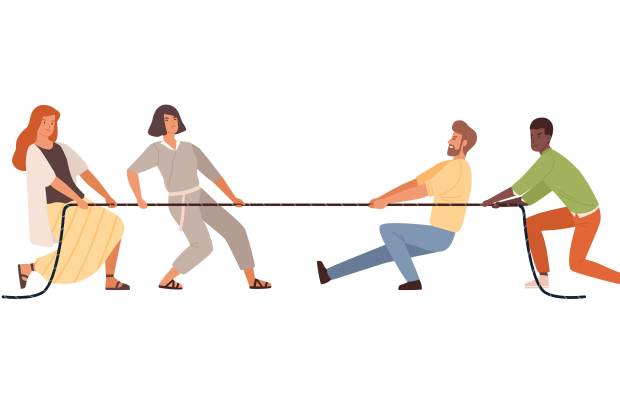Interest in this subject comes from consistent observations over the past ten years, with special focus on more recent history. Essentially this interest comes from two observations:
- Members of the media are mentioning the theme of “national polarization” more frequently, and often asking guest speakers, many of whom are national leaders, to comment on how we, as a nation, might overcome this unwelcome trend of polarization; and
- Guest speakers often respond with an immediate frown, a significant measure of uncertainty, and at least a sense of powerlessness as if this polarization is a wild beast that has been unleashed leaving us to merely ‘wait out’ this season of unrest and hope for better times.
In as much as polarization refers primarily to an emotional process, which is predictable with an inflamed level of chronic anxiety in the relationship system, Bowen theory helps us understand this trend, and how to effectively address this process such that an individual or a small social unit could adopt a way forward offering confidence that mitigation of this process is both reasonable and attainable.
Before speaking more directly to Bowen theory, below is a short list of comments we may hear from commentators speaking to a polarized culture:
- “Each one of us needs to work on searching for compromises to resolve difficult problems.”
- “Each one of us needs to take a chill pill, calm down, and don’t let others upset us”
- “Each one of us needs to learn how to be a bit more gracious to our opponents”
- “Each one of us needs to see a bit less “black and white” and a bit more “gray” in the national challenges we face”
While each of the above comments may seem reasonable, they all have a common flaw; namely, they approach a significant disturbance in the social system as a problem representing an amalgamation of individuals functioning poorly. This is the conventional approach to psychological disturbance in which we are encouraged to think about individual pathology, addressed by the individual correcting his or her psychopathology, with the ‘hope’ that this would have a positive effect on the collective.
Typical of this individual approach to psychopathology is Melanie Klein, the founder of ObjectRelations Theory. Klein suggested that all infants begin development by passing through a Paranoid-schizoid position from birth to about the 6thmonth. Briefly stated, in order to cope with relationship anxiety, the infant utilizes the phantasies of “splitting” and “projection identification” in order to bind anxiety until a more mature understanding of the world is developed. Splitting is about the interior work of categorizing objects (especially the mother) as either good or bad. This process of labelling the other soothes the child’s anxiety. In essence, the infant creates two mental images of mother –the ‘good mother’ who helps me, and the ‘bad mother’ who is punitive. The infant exercises mental energy to cling positively to the ‘good mother’, and an equal measure of energy to defeat the ‘bad mother’. In order for the infant to manage his or her anxiety, this split is sustained, projecting this ‘good’ and ‘bad’ onto other external objects.
Optimally, by the 6th month, the infant is bringing this split together beginning to see the mother as one object (good and bad), and therefore the benefit of projecting self onto the mother is no longer essential. The splitting defense begins to fade. In a more chaotic family, the splitting defense will not be effectively resolved, while in a more stable family the splitting defense begins to be resolved–though a residue of the defense will reappear when the level of anxiety rises within the individual.
Those adults reared in more chaotic families will persist in this Paranoid-schizoid position having never resolved the splitting defense in early years, and will largely see the world as filled with good and bad objects–a projection of their own interior world. Other adults, who are reared in more stable families, will not be so inclined to engage in this splitting defense seeing ‘good’ and ‘bad’ in all people. Still, these adults remain vulnerable when this split is intensively acted out in other significant relationships.
Theoretically, these adults have the ability to “gain insight”, especially through the transference with therapist, to see how they are swayed into seeing the world as being filled with ‘good objects’ and ‘bad objects’. Ultimately, the adult individual brings these objects together, just as they did, to some degree, with mother at an early age.
The point I am making here is that in traditional psychological understanding of human development, in terms of overcoming the condition of polarization (here the Paranoid-schizoid position), it is the individual, focusing on their own pathology, that begins the healing process such that this trend of polarized (split) begins to abate. Unfortunately, this individual model presents a world that includes more mature adults, who have resolved their need to ‘split’, and less mature adults, who cannot help themselves from engaging in the splitting defense. Should the culture become ‘contaminated’ with a greater number of less mature adults–triggering the splitting defense–then we enter into cultural wars between the “bad” adults (still splitting the world) attacking “good” adults, who are more mature. This does not suggest a positive prognosis.
Bowen theory sees this differently. What is infected, fixated, truncated is not individuals, but systems that live within the variable of chronic anxiety. The level of chronic anxiety is not static, though the presence of chronic anxiety remains the governing force in all systems. A family can go through a season in which the level of chronic anxiety is more manageable, and the need for the system to ‘split’ (through conflict, accommodation, reciprocity and projection) is not so pressing. Yet each family system, truly devoted to achieving important goals, will enter seasons in which chronic anxiety rises, and the need to ‘split’ becomes strong. Suddenly there is a need for conflict (fighting a bad spouse), or accommodation (yielding to a bad spouse), reciprocity (adopting an opposing position from a bad spouse), or projection (designating a child as ‘all bad’ or ‘all good’). Adopting one or more of these four behavioral patterns binds anxiety that perceptively is not resolved. The pattern of family splitting will vary in accordance with levels of differentiation in each family. Nevertheless, splitting, under these four patterns, is something that all families do–either resulting in stuck togetherness, or family regression.
The point here is that chronic anxiety, which has its genesis in the family unit, is a function and primary governing force of the relationship system. A residue will reside within the individual, but the treatment of the individual without accounting for the larger system will thwart a healing process. Unless the relationship system remains in constant consideration, changes in one part of the system (an individual for example) will be followed by an equal and opposite change in another part of the system, perpetuating homeostasis throughout. In short, to use Klein’s words, unless the splitting defense of the entire system is considered, and the treatment of the entire system, then there is little reason to be hopeful about mitigating a significant emotional disturbance.
With the assumption that polarization is but one symptom of chronic anxiety, Bowen offered two key ideas representing significant hope in mitigating, and resolving an emotional disturbance where two “sides” seem to be threatened (polarized) by the other. The first was that if the Therapist can be emotionally engaged with both sides of the polarity, yet avoid being triangled into either ‘side’, the disturbance will begin to calm down until a working through process begins. This includes the process of detriangling as well as taking “I positions” that do not cater to the polarization, but represent principled thinking in the therapist. Another way of saying this is that if the therapist can avoid being pulled into the polarization, and not allow his or her own polarization to emerge, yet sustain emotional connection with both polarized individuals, then a healing process will begin.
The key here is that some residue of polarization exists within all of us, within our emotional system, but can be held at bay by an intellectual system that works against such a splitting defense.“There is so much good in the worst of us, and so much bad in the best of us, that it be hooves us all not to talk about the rest of us”(attributed to Louis Stevenson). As the therapist (or parent, or politician, or manager) refuses to take a ‘side’, yet remains emotionally engaged, then others will begin to go and do likewise.




